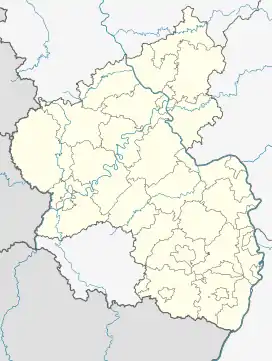Greimersburg | |
|---|---|
Location of Greimersburg within Cochem-Zell district  | |
 Greimersburg  Greimersburg | |
| Coordinates: 50°11′6.24″N 7°8′23.16″E / 50.1850667°N 7.1397667°E | |
| Country | Germany |
| State | Rhineland-Palatinate |
| District | Cochem-Zell |
| Municipal assoc. | Cochem |
| Government | |
| • Mayor (2019–24) | Hans-Werner Junglas[1] |
| Area | |
| • Total | 10.16 km2 (3.92 sq mi) |
| Elevation | 420 m (1,380 ft) |
| Population (2021-12-31)[2] | |
| • Total | 713 |
| • Density | 70/km2 (180/sq mi) |
| Time zone | UTC+01:00 (CET) |
| • Summer (DST) | UTC+02:00 (CEST) |
| Postal codes | 56814 |
| Dialling codes | 02671 |
| Vehicle registration | COC |
| Website | www.greimersburg.de |
Greimersburg is an Ortsgemeinde – a municipality belonging to a Verbandsgemeinde, a kind of collective municipality – in the Cochem-Zell district in Rhineland-Palatinate, Germany. It belongs to the Verbandsgemeinde of Cochem, whose seat is in the like-named town.
Geography
The municipality lies in the Eifel between Trier and Koblenz near the towns of Cochem on the Moselle and Kaisersesch.
History
In the 7th century, Greimersburg had its first documentary mention as one of Frankish ruler Pepin the Elder’s holdings. Electoral-Trier overlordship was swept away in 1794 by the French Revolutionary occupation. In 1815 Greimersburg was assigned to the Kingdom of Prussia at the Congress of Vienna. Since 1946, it has been part of the then newly founded state of Rhineland-Palatinate.
Religion
Until 1728, Greimersburg was assigned to the Catholic parish of Klotten. Today it forms a parish together with Landkern.
Politics
Municipal council
The council is made up of 12 council members, who were elected at the municipal election held on 7 June 2009, and the honorary mayor as chairman.
The municipal election held on 7 June 2009 yielded the following results:[3]
| Lauxen | Krämer | Total | |
| 2009 | 9 | 3 | 12 seats |
| 2004 | 10 | 2 | 12 seats |
Mayor
Greimersburg’s mayor is Hans-Werner Junglas, elected in 2012. He succeeded Paul Lauxen who held this position since 2001.[4]
Coat of arms
The German blazon reads: In Silber, ein durchgehendes rotes Kreuz belegt mit einem schwarzen Schild, darin ein goldener Kreuzstab mit daran hängenden silbernen Glöckchen.[5]
The municipality’s arms might in English heraldic language be described thus: Argent a cross gules surmounted by an inescutcheon sable charged with a cross tau Or, hanging from each of whose arms a bell of the first.
The arms were designed by A. Friderichs of Zell.
Culture and sightseeing
Buildings
The following are listed buildings or sites in Rhineland-Palatinate’s Directory of Cultural Monuments:
- St. Antonius Abbas Catholic Chapel; aisleless church, 1777, expanded with a schoolhouse in 1867; basalt warriors’ memorial with relief
- Hauptstraße (no number): estate complex; timber-frame house, partly solid, 18th century, shed/stable
- Hauptstraße 36: timber-frame house, plastered and slated, 18th century (?)
- Landkerner Straße 2: barn with oven, 19th century
- On Landesstraße (State Road) 98, going towards Landkern: wayside chapel, from 1861
- North of Greimersburg: basalt wayside cross from 1776
- South of Greimersburg: basalt wayside cross from 1790
- Southwest of Greimersburg: basalt wayside cross; niche cross, 17th century (?)[6]
Natural monuments
- Tal der Wilden Endert (“Valley of the Wild Endert”) with its former mills.
References
- ↑ Direktwahlen 2019, Landkreis Cochem-Zell, Landeswahlleiter Rheinland-Pfalz, accessed 9 August 2021.
- ↑ "Bevölkerungsstand 2021, Kreise, Gemeinden, Verbandsgemeinden" (in German). Statistisches Landesamt Rheinland-Pfalz. 2022.
- ↑ Kommunalwahl Rheinland-Pfalz 2009, Gemeinderat
- ↑
- ↑ Wappenbuch des Landkreises Cochem-Zell (von A. Friderichs), Darmstadt 2001, S. 48/9.
- ↑ Directory of Cultural Monuments in Cochem-Zell district
External links
- Municipality’s official webpage (in German)